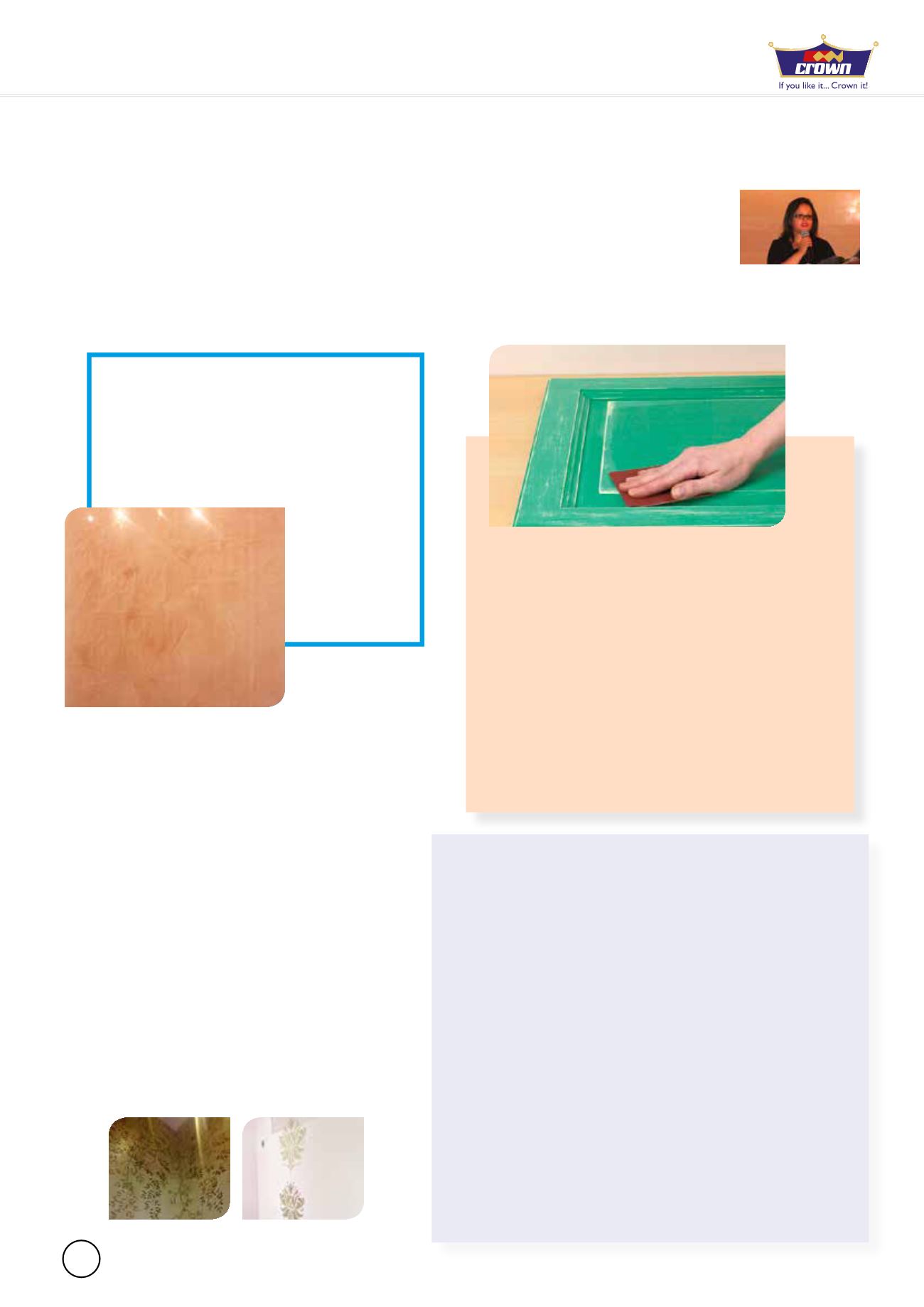
January 2014
16
How to Create Decorative Paint Techniques
Some paint effects are used to add detail, such as stencilling, distressing, and some trompe l’oeil effects. Others
are used to decorate whole walls or rooms, using a discontinuous topcoat of colour to create depth and texture. The
topcoat is chosen to complement the base colour of the wall where it shows through. Traditionally a translucent glaze
is used for the finish coat, although other paints are sometimes used. Once you are familiar with the key techniques of the effects explained
here, you can experiment with colours, layers, and tools to create effects of your own.
Learn how to create faux finishes such as sponging, graining, stencilling and distressing.
Excerpted from Interior Designer Shrinal Patel Crown Paints Kenya Ltd
Trompe l’oeil
Trompe l’oeil translates as “trick of the eye” and
includes all those paint effects that try to mimic a
different surface. Examples include marbling, where
paint and glaze are carefully applied to create the
appearance of marble, and tricks such as recreating
the look of old stone on a new plaster surface.
To produce
convincing
trompe l’oeil takes
practice, you can
hone your skills on
some scrap paper
before tackling a
new project.
Stencilling
Stencils are normally made from acetate or
cardboard and can be bought ready-to-use, or
you can cut your own. Any paint can be used for
stencilling, but water-based options dry quickly and
are the most user-friendly.
Use a very small amount of paint on a special
stencilling or small stippling brush and dab lightly
into the stencil. Stencil crayons or aerosol paints can
also be used. You can apply a coat of flat colour, or
create a three-dimensional effect by concentrating
colour around the edge of a design. This creates a
central highlight. You can also apply more paint on
one side to suggest directional light.
Using a Stencil
Attach the stencil to the surface with low-tack
painter’s tape. Use a stencilling brush in an up-and-
down motion to apply the paint. Remove the stencil
carefully. Choose the next stencil location randomly,
or create a regular pattern.
Distressing
There are several techniques that can provide the illusion
of age. Masking areas with petroleum jelly or glue prevents
paint from adhering so that once the surface is painted and
the area is sanded, the masked areas lose all their paint to
provide a patchy, aged finish. Surfaces can also be physically
distressed with strokes of a hammer or other objects.
Accentuate the texture by rubbing some coloured wax into
the surface or colour-washing.
Creating Aging Effects
When using these effects, think carefully where you would
expect to find natural wear, such as on the edges of a door,
or on the area around a handle. The more layers of different
coloured paint applied to an area, the greater the effect.
Sponging On Effects
Glaze or latex can be applied over a flat coat of paint to create a
textured effect. Here, sponging on paint is described, although
you can experiment with other “tools” — such as rags or bags.
Whatever tool you use, the general technique is similar.
The first step is to paint a base coat of latex or eggshell onto the
wall. When this is dry, pour a small amount of your topcoat of paint
or glaze into a roller tray. Dip in your chosen tool and make sure it is
well coated. Remove the excess paint by dabbing it off on the ridged
section of the tray, then on some newspaper, until a light touch
produces a mottled mark rather than a solid block of colour.
Begin to apply it to the wall in a random pattern, varying the side of
the tool that you use for each mark. Build up the effect slowly rather
than attempting a dense coat the first time. Go over the whole
surface with one very light coat first, then check for even coverage.
Apply subsequent layers until the desired result is achieved.
Creating a random yet even pattern is harder than it looks and you
may want to practice on some scrap paper first. However, mistakes
can be corrected and evened out by applying paint.


